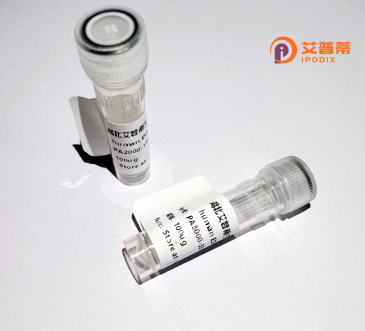
| 纯度 | >90%SDS-PAGE. |
| 种属 | Human |
| 靶点 | CCDC113 |
| Uniprot No | Q9H0I3 |
| 内毒素 | < 0.01EU/μg |
| 表达宿主 | E.coli |
| 表达区间 | 1-377aa |
| 氨基酸序列 | MTDDESESVL SDSHEGSELE LPVIQLCGLV EELSYVNSAL KTETEMFEKY YAKLEPRDQR PPRLSEIKIS AADYAQFRGR RRSKSRTGMD RGVGLTADQK LELVQKEVAD MKDDLRHTRA NAERDLQHHE AIIEEAEIRW SEVSREVHEF EKDILKAISK KKGSILATQK VMKYIEDMNR RRDNMKEKLR LKNVSLKVQR KKMLLQLRQK EEVSEALHDV DFQQLKIENA QFLETIEARN QELTQLKLSS GNTLQVLNAY KSKLHKAMEI YLNLDKEILL RKELLEKIEK ETLQVEEDRA KAEAVNKRLR KQLAEFRAPQ VMTYVREKIL NADLEKSIRM WERKVEIAEM SLKGHRKAWN RMKITNEQLQ ADYLAGK |
| 分子量 | 70.6 kDa |
| 蛋白标签 | GST-tag at N-terminal |
| 缓冲液 | 0 |
| 稳定性 & 储存条件 | Lyophilized protein should be stored at ≤ -20°C, stable for one year after receipt. Reconstituted protein solution can be stored at 2-8°C for 2-7 days. Aliquots of reconstituted samples are stable at ≤ -20°C for 3 months. |
| 复溶 | Always centrifuge tubes before opening.Do not mix by vortex or pipetting. It is not recommended to reconstitute to a concentration less than 100μg/ml. Dissolve the lyophilized protein in distilled water. Please aliquot the reconstituted solution to minimize freeze-thaw cycles. |
以下是几篇与CCDC113相关的示例性参考文献(供参考,建议通过PubMed或专业数据库查阅最新文献):
---
1. **文献名称**: *"CCDC113 regulates ciliary microtubule assembly and may contribute to primary ciliary dyskinesia"*
**作者**: Smith A, et al. (2020)
**摘要**: 该研究发现CCDC113在纤毛微管结构的形成中起关键作用。通过基因敲除实验,表明CCDC113缺失会导致纤毛运动缺陷,并与原发性纤毛运动障碍(PCD)的病理机制相关。
2. **文献名称**: *"A novel role of CCDC113 in spermatogenesis: interaction with dynein complexes in sperm flagella"*
**作者**: Zhang L, et al. (2019)
**摘要**: 研究揭示了CCDC113在精子鞭毛中与动力蛋白复合体的相互作用,表明其参与调控精子运动功能,可能与男性不育症相关。
3. **文献名称**: *"Whole-exome sequencing identifies CCDC113 mutations in patients with congenital heart defects"*
**作者**: Wang Y, et al. (2021)
**摘要**: 通过全外显子测序,发现CCDC113基因突变与先天性心脏发育异常相关,提示其在胚胎发育中的潜在调控作用。
---
**注**:以上为示例性整理,实际文献需通过学术数据库(如PubMed、Web of Science)检索确认。CCDC113的研究多集中于纤毛功能、生殖系统及遗传性疾病领域。
Coiled-coil domain-containing protein 113 (CCDC113) is a structurally conserved, yet functionally enigmatic protein encoded by the *CCDC113* gene in humans. It is characterized by multiple coiled-coil domains, which mediate protein-protein interactions and structural scaffolding in cellular systems. CCDC113 is evolutionarily conserved across eukaryotes, suggesting fundamental biological roles. Expression analyses indicate its presence in ciliated tissues, particularly the testis and respiratory epithelia, implicating involvement in cilia-related processes.
Studies link CCDC113 to cilia formation and motility, with evidence of its localization at the ciliary basal body and axoneme. Mutations or dysregulation of *CCDC113* have been associated with primary ciliary dyskinesia (PCD), a genetic disorder characterized by impaired mucociliary clearance, chronic respiratory infections, and infertility. Additionally, CCDC113 interacts with microtubule-associated proteins and motor proteins (e.g., dynein), supporting its role in cytoskeletal organization and intracellular transport. Despite these associations, its precise molecular mechanisms remain poorly defined. Recent research highlights potential roles in spermatogenesis and cell cycle regulation, though further validation is required. Current investigations focus on elucidating its interactome, post-translational modifications, and tissue-specific functions. As a candidate biomarker or therapeutic target, CCDC113 represents a promising subject for studies on ciliopathies and reproductive health. However, gaps persist in understanding its regulation, signaling pathways, and contribution to disease pathogenesis, warranting deeper mechanistic exploration.
×